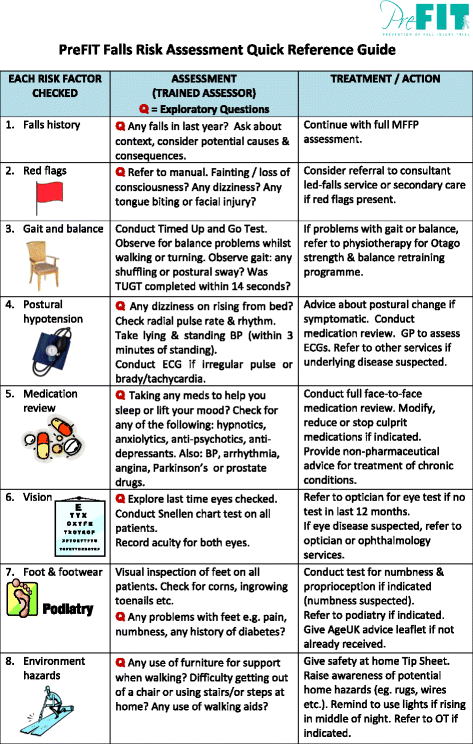How Dementia Fall Risk can Save You Time, Stress, and Money.
How Dementia Fall Risk can Save You Time, Stress, and Money.
Blog Article
Unknown Facts About Dementia Fall Risk
Table of Contents10 Easy Facts About Dementia Fall Risk DescribedAbout Dementia Fall RiskNot known Details About Dementia Fall Risk Indicators on Dementia Fall Risk You Should Know
An autumn danger evaluation checks to see how most likely it is that you will certainly fall. The analysis generally includes: This consists of a series of questions regarding your overall health and wellness and if you've had previous drops or problems with equilibrium, standing, and/or strolling.STEADI includes testing, examining, and intervention. Interventions are referrals that may lower your risk of falling. STEADI includes three steps: you for your danger of succumbing to your risk variables that can be boosted to try to avoid drops (as an example, balance issues, impaired vision) to minimize your risk of falling by utilizing reliable approaches (as an example, supplying education and resources), you may be asked a number of concerns consisting of: Have you dropped in the previous year? Do you feel unsteady when standing or walking? Are you stressed over falling?, your service provider will certainly evaluate your toughness, equilibrium, and stride, utilizing the complying with loss assessment tools: This examination checks your gait.
After that you'll take a seat once more. Your provider will certainly inspect the length of time it takes you to do this. If it takes you 12 seconds or more, it might mean you go to higher danger for a loss. This test checks toughness and balance. You'll being in a chair with your arms crossed over your upper body.
The settings will certainly get more difficult as you go. Stand with your feet side-by-side. Move one foot midway ahead, so the instep is touching the large toe of your other foot. Relocate one foot completely in front of the other, so the toes are touching the heel of your other foot.
Some Known Questions About Dementia Fall Risk.
Most falls happen as an outcome of multiple contributing variables; for that reason, managing the risk of dropping starts with recognizing the elements that add to drop threat - Dementia Fall Risk. Several of one of the most pertinent danger aspects consist of: History of previous fallsChronic medical conditionsAcute illnessImpaired gait and equilibrium, reduced extremity weaknessCognitive impairmentChanges in visionCertain risky medications and polypharmacyEnvironmental elements can additionally enhance the threat for drops, including: Poor lightingUneven or harmed flooringWet or unsafe floorsMissing or damaged handrails and order barsDamaged or incorrectly fitted equipment, such as beds, mobility devices, or walkersImproper use assistive devicesInadequate guidance of individuals staying in the NF, including those that exhibit aggressive behaviorsA effective fall danger monitoring program requires a thorough professional analysis, with input from all participants of the interdisciplinary team

The care plan need to additionally consist of interventions that are system-based, such as those that promote a safe setting (suitable lights, hand rails, grab bars, and so on). The performance of the treatments must be examined occasionally, and the care plan modified as required to mirror changes in the fall danger evaluation. Applying a fall risk administration system making use of evidence-based best method can decrease the prevalence of drops in the NF, while restricting the possibility for fall-related injuries.
How Dementia Fall Risk can Save You Time, Stress, and Money.
The AGS/BGS guideline suggests evaluating all grownups aged 65 years and older for loss threat each year. This screening consists of asking people whether they have actually fallen 2 or even more times in the past year or looked for clinical interest for a fall, or, if they have not fallen, whether they feel unsteady when walking.
Individuals who have actually fallen once without injury should have their equilibrium and stride assessed; those with gait or equilibrium problems ought to get extra assessment. A history of 1 fall without injury and without stride or balance problems does not call for further evaluation beyond ongoing yearly autumn risk testing. Dementia Fall Risk. A loss risk assessment is required as part of the Welcome to Medicare evaluation

The Main Principles Of Dementia Fall Risk
Documenting a drops history is one of the quality indicators for loss avoidance and administration. Psychoactive medications in specific are independent forecasters of drops.
Postural hypotension can usually be eased by reducing the dose of blood pressurelowering drugs and/or stopping medications that have orthostatic hypotension as a negative effects. Use above-the-knee support hose and sleeping with the head of the bed raised may also lower postural reductions in high blood pressure. The suggested elements of a fall-focused checkup are revealed in Box 1.

A pull time better than or equal to 12 secs recommends high autumn threat. The 30-Second Chair Stand test assesses lower extremity toughness and balance. Being incapable to stand from a chair of knee elevation without here using one's arms suggests boosted loss danger. The 4-Stage Equilibrium examination evaluates fixed equilibrium by having the patient stand in 4 positions, each gradually a lot more difficult.
Report this page